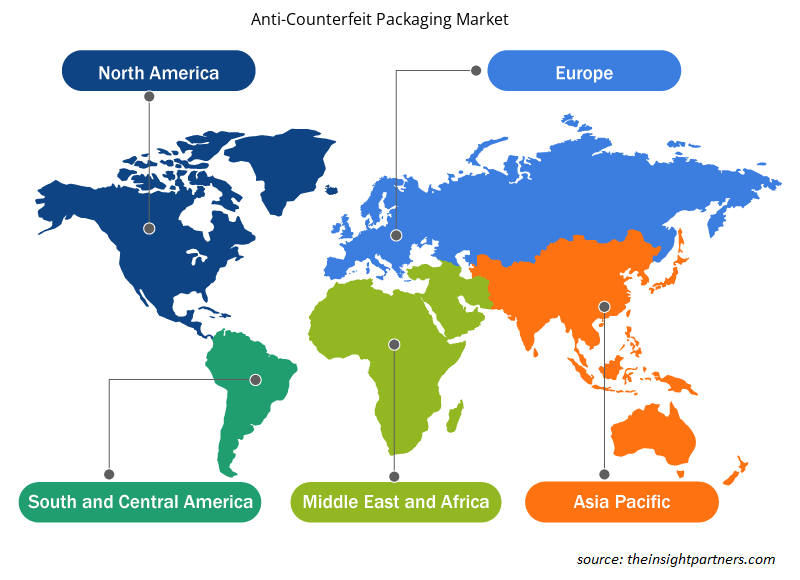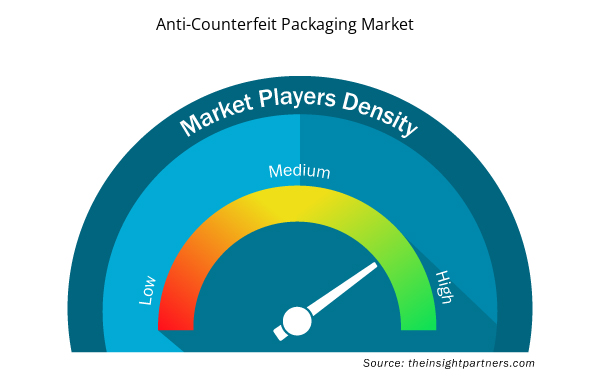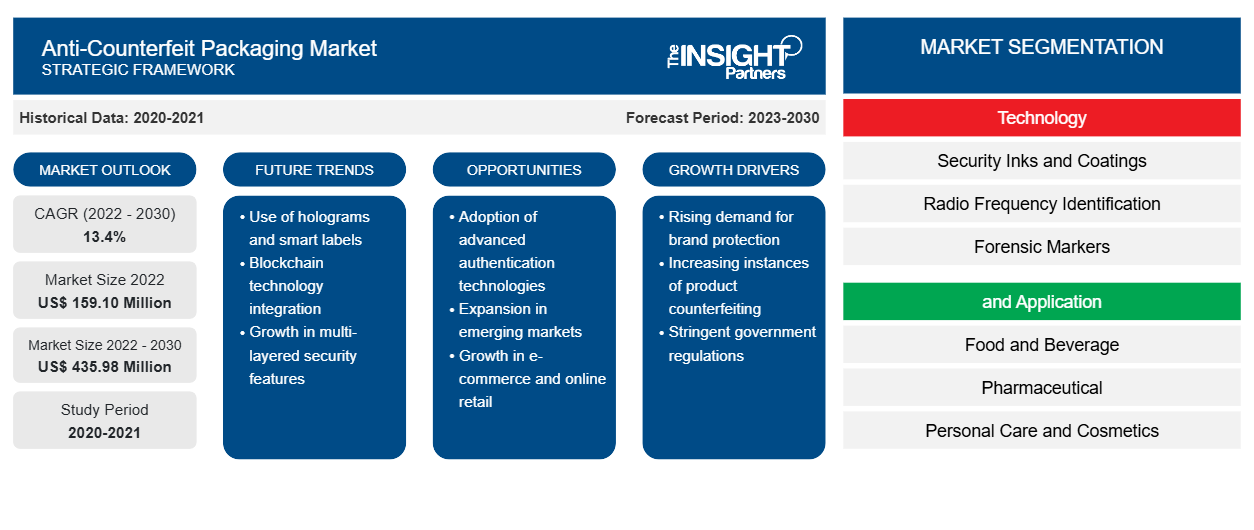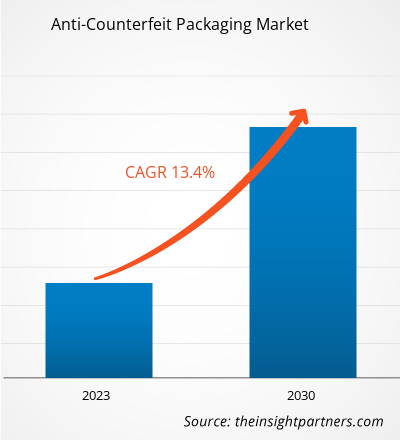[研究报告]防伪包装市场规模预计将从2022年的1.591亿美元增长到2030年的4.3598亿美元;预计 2022年至2030年的复合年增长率为13.4%。
市场洞察和分析师观点:
防伪包装是指实施各种措施和技术来保护产品免遭假冒、复制或篡改事件。假冒产品对消费者的健康、安全和品牌声誉构成重大风险。防伪包装解决方案旨在提供身份验证、可追溯性和安全功能,帮助识别正品并阻止假冒。这些解决方案通常涉及使用先进技术,例如全息图、唯一序列化代码、防篡改标签、RFID标签或隐形墨水。制药、食品和饮料、纺织和服装以及电气和电子行业对防伪包装的需求日益增加。这一因素极大地推动了全球防伪包装市场的发展。
增长动力和挑战:
假冒药品是指故意贴错标签、掺假或质量低劣的假冒或未经授权的仿制品。假冒药品对公众健康和安全构成重大风险,引起监管机构、制药公司和消费者的日益关注。制药行业特别容易受到假冒的影响,因为药品价值高、需求大、全球供应链复杂,而且造假者可能获得巨额经济利益。据国际刑警组织称,全球非法药品贸易是一个重要的犯罪领域,因为它吸引了全球有组织犯罪集团的参与;其价值达 44 亿美元。此外,假冒已成为全球市场的一个普遍问题,影响到各个行业,并对政府、企业和消费者构成重大挑战。在全球化、电子商务和先进技术的推动下,造假者利用了供应链的复杂性和消费者对平价产品的需求。假冒造成重大经济损失和失业,危及消费者安全,破坏品牌声誉和市场信任。根据北卡罗来纳州立大学的数据,假冒商品的贸易额从 1980 年代的 300 亿美元增长到 2021 年的 6000 亿美元。假冒商品的主要目标市场包括消费品、航空部件、烟草、电子产品、汽车零部件、药品、工业部件、服装和食品。然而,防伪包装解决方案的实施和使用可能很复杂,需要专业知识和设备。将防伪包装纳入现有的供应链或产品认证系统可能很复杂。集成可能需要修改包装线、实施新的软件或硬件,或与供应链中的多个利益相关者进行协调。这些集成挑战可能会阻碍企业采用全面的防伪解决方案。因此,所有这些因素都在阻碍对防伪包装的需求。
定制此报告以满足您的需求
您可以免费定制任何报告,包括本报告的部分内容、国家级分析、Excel 数据包,以及为初创企业和大学提供优惠和折扣
- 获取此报告的关键市场趋势。这个免费样品将包括数据分析,从市场趋势到估计和预测。
报告细分和范围:
全球防伪包装市场根据技术、应用和地域进行细分。根据技术,防伪包装市场细分为安全油墨和涂料、射频识别 ( RFID )、法医标记、防篡改、全息图、条形码等。根据应用,防伪包装市场细分为食品和饮料、医药、个人护理和化妆品、电气和电子、纺织和服装、汽车等。按地域划分,防伪包装市场细分为北美(美国、加拿大和墨西哥)、欧洲(德国、法国、意大利、英国、俄罗斯和欧洲其他地区)、亚太地区(澳大利亚、中国、日本、印度、韩国和亚太地区其他地区)、中东和非洲(南非、沙特阿拉伯、阿联酋和中东和非洲其他地区)以及南美洲和中美洲(巴西、阿根廷和南美洲和中美洲其他地区)
节段分析:
根据技术,防伪包装市场细分为安全油墨和涂料、射频识别 (RFID)、法医标记、防篡改、全息图、条形码等。射频识别 (RFID) 部分在防伪包装市场中占有相当大的份额,预计在预测期内将实现最快的增长。射频识别 (RFID) 是一种使用无线电波的无线技术,被广泛用于打击假冒和改进产品认证。RFID 标签可以整合到包装材料、标签等中,以在整个供应链中识别、跟踪和管理包装物品。
根据应用,防伪包装市场细分为食品和饮料、药品、个人护理和化妆品、电气和电子、纺织和服装、汽车等。食品和饮料部门在防伪包装市场中占有重要份额,预计在预测期内将实现大幅增长。防伪包装在食品和饮料行业中发挥着至关重要的作用,可确保消费者安全、维护产品完整性并保护品牌声誉。这些包装解决方案增强了消费者对所购买食品和饮料的真实性和安全性的信心。所有这些因素都有可能推动全球防伪包装市场的发展。
区域分析:
根据地理位置,防伪包装市场分为五个主要区域——北美、欧洲、亚太、南美和中美以及中东和非洲。全球防伪包装市场以北美为主,2022 年市场规模超过 5000 万美元。北美是全球市场的主要贡献者。预计 2022 年至 2030 年亚太地区的复合年增长率将超过 14%。亚太地区的防伪包装市场分为澳大利亚、中国、印度、日本、韩国和亚太其他地区。推动该地区防伪包装市场增长的主要因素之一是假冒案件的增多以及与防伪包装相关的严格规定。亚太地区各个行业的假冒产品数量显著增加,包括医药、消费品、食品和饮料以及电子产品。这引发了人们对产品安全性、真实性和完整性的担忧,导致对防伪措施的需求增加。预计欧洲也将出现可观的增长,到 2030 年将达到约 9,000 万美元。
行业发展和未来机遇:
防伪包装市场的主要参与者已经采取了各种举措。例如,2023 年 6 月,Octane5 International LLC 在内华达州拉斯维加斯举行的国际许可卓越奖颁奖典礼上被评为“最具影响力的服务提供商”。
防伪包装市场区域洞察
Insight Partners 的分析师已详尽解释了预测期内影响防伪包装市场的区域趋势和因素。本节还讨论了北美、欧洲、亚太地区、中东和非洲以及南美和中美洲的防伪包装市场细分和地理位置。

- 获取防伪包装市场的区域具体数据
防伪包装市场报告范围
| 报告属性 | 细节 |
|---|---|
| 2022 年市场规模 | 1.591亿美元 |
| 2030 年的市场规模 | 4.3598亿美元 |
| 全球复合年增长率(2022 - 2030 年) | 13.4% |
| 史料 | 2020-2021 |
| 预测期 | 2023-2030 |
| 涵盖的领域 | 按技术分类
|
| 覆盖地区和国家 | 北美
|
| 市场领导者和主要公司简介 |
|
防伪包装市场参与者密度:了解其对业务动态的影响
防伪包装市场正在快速增长,这得益于终端用户需求的不断增长,而这些需求又源于消费者偏好的不断变化、技术进步以及对产品优势的认识不断提高等因素。随着需求的增加,企业正在扩大其产品范围,进行创新以满足消费者的需求,并利用新兴趋势,从而进一步推动市场增长。
市场参与者密度是指在特定市场或行业内运营的企业或公司的分布情况。它表明在给定市场空间中,相对于其规模或总市场价值,有多少竞争对手(市场参与者)存在。
在防伪包装市场运营的主要公司有:
- 阿若空军基地
- Octane5 国际有限责任公司
- Antares Vision SpA
- CCL工业公司
- 艾利丹尼森公司
免责声明:上面列出的公司没有按照任何特定顺序排列。

- 了解防伪包装市场的主要参与者概况
COVID-19 影响:
COVID-19 疫情影响了各国几乎所有行业。北美、欧洲、亚太地区 (APAC)、南美和中美 (SAM) 以及中东和非洲 (MEA) 的封锁、旅行限制和企业停工阻碍了多个行业的增长,包括化学品和材料行业。制造部门的关闭扰乱了全球供应链、制造活动、交付时间表以及必需品和非必需品销售。2020 年,各公司的产品交付延迟,产品销量下滑。由于疫情引发的经济衰退,消费者在购买决策方面变得更加谨慎和挑剔。由于收入低和收入前景不确定,消费者大幅减少了非必需品的购买,尤其是在发展中地区。由于疫情初期消费者需求减少,许多防伪包装制造商面临利润下降。然而,到 2021 年底,许多国家已经完全接种疫苗,这些国家的政府宣布放宽某些规定,包括封锁和旅行禁令。人们开始到不同的地方旅行,这增加了对防伪包装的需求, 从而推动了防伪包装的需求。所有这些因素都对全球防伪包装市场的增长产生了积极影响。
竞争格局和重点公司:
全球防伪包装市场的一些知名企业包括 Arjo AB、Octane5 International LLC、Antares Vision SpA、CCL Industries Inc、Avery Dennison Corp、The Label Printers LP、KURZ Transfer Products LP、Gestion Groupe Optel Inc、Brady Corp 和 Constantia Flexibles International GmbH。这些企业提供高质量的防伪包装,满足全球市场上大量消费者的需求。
- 历史分析(2 年)、基准年、预测(7 年)及复合年增长率
- PEST 和 SWOT 分析
- 市场规模价值/数量 - 全球、区域、国家
- 行业和竞争格局
- Excel 数据集



Report Coverage
Revenue forecast, Company Analysis, Industry landscape, Growth factors, and Trends

Segment Covered
This text is related
to segments covered.

Regional Scope
North America, Europe, Asia Pacific, Middle East & Africa, South & Central America

Country Scope
This text is related
to country scope.
常见问题
Counterfeit pharmaceutical products are fake or unauthorized replicas of genuine medications intentionally mislabeled, adulterated, or substandard in quality. Counterfeit pharmaceutical products pose significant risks to public health and safety, leading to a growing concern among regulatory bodies, pharmaceutical companies, and consumers. The pharmaceutical industry is particularly vulnerable to counterfeiting due to the high value and demand for medications, complex global supply chains, and the potential for substantial financial gain for counterfeiters.
The major players operating in the global anti-counterfeit packaging market are Arjo AB, Octane5 International LLC, Antares Vision SpA, CCL Industries Inc, Avery Dennison Corp, The Label Printers LP, KURZ Transfer Products LP, Gestion Groupe Optel Inc, Brady Corp, and Constantia Flexibles International GmbH.
Based on the application, pharmaceuticals segment is projected to grow at the fastest CAGR over the forecast period. The pharmaceutical industry is particularly vulnerable to counterfeiting due to potential risks to patient health and fitness. Counterfeit pharmaceuticals can contain incorrect or ineffective ingredients or harmful substances and display incorrect dosages.
North America accounted for the largest share of the global anti-counterfeit packaging market. North America is one of the most significant regions for the anti-counterfeit packaging market owing to drastic increase in the focus on eliminating counterfeit products.
Based on technology, barcode segment mainly has the largest revenue share. The growth of the segment is attributed to the excellent properties of the barcode for anti-counterfeiting. Barcodes are widely used in anti-counterfeit packaging as a simple yet effective method to enhance security and enable product authentication. A barcode is a graphical representation of data that consists of a series of parallel lines and spaces of varying widths.
Developing countries such as India, Brazil, Indonesia, and Mexico are experiencing significant economic growth, industrial development, and increased trade, which is increasing the risk associated with counterfeiting. According to the National Forum to Combat Piracy and Illegality (Fórum Nacional de Combate à Pirataria e a Ilegalidade), in 2021, counterfeiting-related practices cost the Brazilian economy ~US$ 82 billion. Additionally, per the Federation of Indian Chambers of Commerce & Industry (FICCI) report published on September 22, 2022—illicit trade in five key industries, including FMCG, mobile phone, cigarette, and alcohol industries, caused the Indian exchequer a tax loss of US$ 7.93 billion and also resulted in the loss of 1.6 million jobs. As per the World Health Organization, ~120,000 people die each year in Africa due to counterfeit pharmaceuticals.
Trends and growth analysis reports related to Chemicals and Materials : READ MORE..
The List of Companies - Anti-Counterfeit Packaging Marke
- Arjo AB
- Octane5 International LLC
- Antares Vision SpA
- CCL Industries Inc
- Avery Dennison Corp
- The Label Printers LP
- KURZ Transfer Products LP
- Gestion Groupe Optel Inc
- Brady Corp
- Constantia Flexibles International GmbH
The Insight Partners performs research in 4 major stages: Data Collection & Secondary Research, Primary Research, Data Analysis and Data Triangulation & Final Review.
- Data Collection and Secondary Research:
As a market research and consulting firm operating from a decade, we have published and advised several client across the globe. First step for any study will start with an assessment of currently available data and insights from existing reports. Further, historical and current market information is collected from Investor Presentations, Annual Reports, SEC Filings, etc., and other information related to company’s performance and market positioning are gathered from Paid Databases (Factiva, Hoovers, and Reuters) and various other publications available in public domain.
Several associations trade associates, technical forums, institutes, societies and organization are accessed to gain technical as well as market related insights through their publications such as research papers, blogs and press releases related to the studies are referred to get cues about the market. Further, white papers, journals, magazines, and other news articles published in last 3 years are scrutinized and analyzed to understand the current market trends.
- Primary Research:
The primarily interview analysis comprise of data obtained from industry participants interview and answers to survey questions gathered by in-house primary team.
For primary research, interviews are conducted with industry experts/CEOs/Marketing Managers/VPs/Subject Matter Experts from both demand and supply side to get a 360-degree view of the market. The primary team conducts several interviews based on the complexity of the markets to understand the various market trends and dynamics which makes research more credible and precise.
A typical research interview fulfils the following functions:
- Provides first-hand information on the market size, market trends, growth trends, competitive landscape, and outlook
- Validates and strengthens in-house secondary research findings
- Develops the analysis team’s expertise and market understanding
Primary research involves email interactions and telephone interviews for each market, category, segment, and sub-segment across geographies. The participants who typically take part in such a process include, but are not limited to:
- Industry participants: VPs, business development managers, market intelligence managers and national sales managers
- Outside experts: Valuation experts, research analysts and key opinion leaders specializing in the electronics and semiconductor industry.
Below is the breakup of our primary respondents by company, designation, and region:

Once we receive the confirmation from primary research sources or primary respondents, we finalize the base year market estimation and forecast the data as per the macroeconomic and microeconomic factors assessed during data collection.
- Data Analysis:
Once data is validated through both secondary as well as primary respondents, we finalize the market estimations by hypothesis formulation and factor analysis at regional and country level.
- Macro-Economic Factor Analysis:
We analyse macroeconomic indicators such the gross domestic product (GDP), increase in the demand for goods and services across industries, technological advancement, regional economic growth, governmental policies, the influence of COVID-19, PEST analysis, and other aspects. This analysis aids in setting benchmarks for various nations/regions and approximating market splits. Additionally, the general trend of the aforementioned components aid in determining the market's development possibilities.
- Country Level Data:
Various factors that are especially aligned to the country are taken into account to determine the market size for a certain area and country, including the presence of vendors, such as headquarters and offices, the country's GDP, demand patterns, and industry growth. To comprehend the market dynamics for the nation, a number of growth variables, inhibitors, application areas, and current market trends are researched. The aforementioned elements aid in determining the country's overall market's growth potential.
- Company Profile:
The “Table of Contents” is formulated by listing and analyzing more than 25 - 30 companies operating in the market ecosystem across geographies. However, we profile only 10 companies as a standard practice in our syndicate reports. These 10 companies comprise leading, emerging, and regional players. Nonetheless, our analysis is not restricted to the 10 listed companies, we also analyze other companies present in the market to develop a holistic view and understand the prevailing trends. The “Company Profiles” section in the report covers key facts, business description, products & services, financial information, SWOT analysis, and key developments. The financial information presented is extracted from the annual reports and official documents of the publicly listed companies. Upon collecting the information for the sections of respective companies, we verify them via various primary sources and then compile the data in respective company profiles. The company level information helps us in deriving the base number as well as in forecasting the market size.
- Developing Base Number:
Aggregation of sales statistics (2020-2022) and macro-economic factor, and other secondary and primary research insights are utilized to arrive at base number and related market shares for 2022. The data gaps are identified in this step and relevant market data is analyzed, collected from paid primary interviews or databases. On finalizing the base year market size, forecasts are developed on the basis of macro-economic, industry and market growth factors and company level analysis.
- Data Triangulation and Final Review:
The market findings and base year market size calculations are validated from supply as well as demand side. Demand side validations are based on macro-economic factor analysis and benchmarks for respective regions and countries. In case of supply side validations, revenues of major companies are estimated (in case not available) based on industry benchmark, approximate number of employees, product portfolio, and primary interviews revenues are gathered. Further revenue from target product/service segment is assessed to avoid overshooting of market statistics. In case of heavy deviations between supply and demand side values, all thes steps are repeated to achieve synchronization.
We follow an iterative model, wherein we share our research findings with Subject Matter Experts (SME’s) and Key Opinion Leaders (KOLs) until consensus view of the market is not formulated – this model negates any drastic deviation in the opinions of experts. Only validated and universally acceptable research findings are quoted in our reports.
We have important check points that we use to validate our research findings – which we call – data triangulation, where we validate the information, we generate from secondary sources with primary interviews and then we re-validate with our internal data bases and Subject matter experts. This comprehensive model enables us to deliver high quality, reliable data in shortest possible time.


 获取此报告的免费样本
获取此报告的免费样本